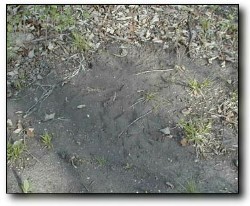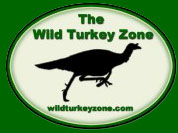|
Fall Scouting Techniques
Fall turkey hunting is almost
an entirely different sport than spring hunting.
The techniques consistent from spring to fall
are good scouting, woodsmanship and correct
calling. I've found the most important part
of fall turkey hunting is spending a lot of
time scouting birds. If you can find a flock
of either hens and poults or gobblers and
pattern their movements, it's much easier
to succeed using any of the fall techniques.
It's always easier to call a turkey to a location
he wants to go to anyway.
The best way to find turkeys
in the fall is to concentrate on the three
basic necessities. They must have food, water
and a roost site.
Favorite food sources in the
fall include white oak acorns, corn, soybeans
and milo in my neck of the woods. I like walking
the oak ridges and hollows looking for scratchings.
Gobblers will scratch in a V pattern, putting
one foot forward and pulling it back and then
repeating it with the other leg. Gobblers
also have a tendency to scratch out around
the base of trees where the mast is often
the most abundant. The V shape of their scratchings
will also tell you the direction the flock
is travelling.
Another good way to locate flocks
of turkeys is to glass crop fields along creek
bottoms or next to woods in the late afternoons
to find feeding flocks.
Water can be at a premium during
the fall season and you won't find turkeys
very far from water at any time of the year.
Turkeys will often leave tracks in the mud
or on sandbars. A gobblers track is about
1/3 larger than a hen's track and the middle
toe is about 3 1/2" to 4" long while
a hen's is less than 3" long. It is also
possible to tell a young gobbler from an old
one. The older gobblers will usually have
larger, knobbier joints on their foot. Sometimes
a younger gobbler track will be larger than
an older bird since the older birds have a
tendency to walk on their toes.
 Another
often overlooked scouting technique which
is very successful in the spring as well is
to find a good dusting / loafing area. A dust
bowl is a shallow depression in loose or sandy
soil where the turkeys dust themselves to
get rid of feather lice (See Picture on Left).
If you can find one of these areas which has
lots of sign including tracks, molted feathers
and droppings around the area, there's a very
good chance turkeys are using the location
daily. Turkeys often spend time in these areas
around midday. Another
often overlooked scouting technique which
is very successful in the spring as well is
to find a good dusting / loafing area. A dust
bowl is a shallow depression in loose or sandy
soil where the turkeys dust themselves to
get rid of feather lice (See Picture on Left).
If you can find one of these areas which has
lots of sign including tracks, molted feathers
and droppings around the area, there's a very
good chance turkeys are using the location
daily. Turkeys often spend time in these areas
around midday.
Roost sites are by far your
best bet and if you can set up on the route
between a flock's roost and their favorite
feeding area, your hunt is half over. Find
roosting sites by watching and/or listening
for flocks as they fly up at night. Or else,
try walking underneath ridges to find the
trees with piles of droppings under them.
|

